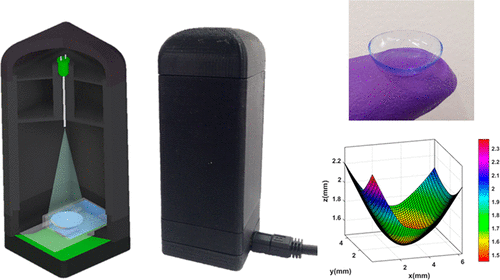Our official English website, www.x-mol.net, welcomes your feedback! (Note: you will need to create a separate account there.)
Computational Sensing of Staphylococcus aureus on Contact Lenses Using 3D Imaging of Curved Surfaces and Machine Learning
ACS Nano ( IF 17.1 ) Pub Date : 2018-03-09 00:00:00 , DOI: 10.1021/acsnano.7b08375 Muhammed Veli 1 , Aydogan Ozcan 1, 2, 3, 4
ACS Nano ( IF 17.1 ) Pub Date : 2018-03-09 00:00:00 , DOI: 10.1021/acsnano.7b08375 Muhammed Veli 1 , Aydogan Ozcan 1, 2, 3, 4
Affiliation

|
We present a cost-effective and portable platform based on contact lenses for noninvasively detecting Staphylococcus aureus, which is part of the human ocular microbiome and resides on the cornea and conjunctiva. Using S. aureus-specific antibodies and a surface chemistry protocol that is compatible with human tears, contact lenses are designed to specifically capture S. aureus. After the bacteria capture on the lens and right before its imaging, the captured bacteria are tagged with surface-functionalized polystyrene microparticles. These microbeads provide sufficient signal-to-noise ratio for the quantification of the captured bacteria on the contact lens, without any fluorescent labels, by 3D imaging of the curved surface of each lens using only one hologram taken with a lens-free on-chip microscope. After the 3D surface of the contact lens is computationally reconstructed using rotational field transformations and holographic digital focusing, a machine learning algorithm is employed to automatically count the number of beads on the lens surface, revealing the count of the captured bacteria. To demonstrate its proof-of-concept, we created a field-portable and cost-effective holographic microscope, which weighs 77 g, controlled by a laptop. Using daily contact lenses that are spiked with bacteria, we demonstrated that this computational sensing platform provides a detection limit of ∼16 bacteria/μL. This contact-lens-based wearable sensor can be broadly applicable to detect various bacteria, viruses, and analytes in tears using a cost-effective and portable computational imager that might be used even at home by consumers.
中文翻译:

使用曲面的3D成像和机器学习对隐形眼镜上的金黄色葡萄球菌进行计算感测
我们提出了一种基于隐形眼镜的经济高效且可移植的平台,用于无创检测金黄色葡萄球菌,它是人眼微生物组的一部分,位于角膜和结膜上。使用金黄色葡萄球菌特异性抗体和与人的眼泪兼容的表面化学方案,隐形眼镜被设计为特异性捕获金黄色葡萄球菌。在细菌捕获到透镜上之后以及即将成像之前,捕获的细菌会被表面官能化的聚苯乙烯微粒标记。这些微珠通过仅使用一张无透镜芯片上拍摄的全息图对每个透镜的曲面进行3D成像,从而为定量隐形眼镜上捕获的细菌提供了足够的信噪比,而没有任何荧光标记。显微镜。在使用旋转场变换和全息数字聚焦对隐形眼镜的3D表面进行计算重建之后,采用机器学习算法自动对镜片表面的珠子数量进行计数,从而揭示所捕获细菌的数量。为了证明其概念验证性,我们创建了一款重量为77 g的现场便携式且经济高效的全息显微镜,由笔记本电脑控制。我们使用每天都掺有细菌的隐形眼镜,证明了该计算感应平台的检出限为〜16个细菌/μL。这种基于隐形眼镜的可穿戴式传感器可广泛应用于检测成本低廉的便携式计算成像器,以检测眼泪中的各种细菌,病毒和分析物,该成像器甚至可以在消费者在家中使用。
更新日期:2018-03-09
中文翻译:

使用曲面的3D成像和机器学习对隐形眼镜上的金黄色葡萄球菌进行计算感测
我们提出了一种基于隐形眼镜的经济高效且可移植的平台,用于无创检测金黄色葡萄球菌,它是人眼微生物组的一部分,位于角膜和结膜上。使用金黄色葡萄球菌特异性抗体和与人的眼泪兼容的表面化学方案,隐形眼镜被设计为特异性捕获金黄色葡萄球菌。在细菌捕获到透镜上之后以及即将成像之前,捕获的细菌会被表面官能化的聚苯乙烯微粒标记。这些微珠通过仅使用一张无透镜芯片上拍摄的全息图对每个透镜的曲面进行3D成像,从而为定量隐形眼镜上捕获的细菌提供了足够的信噪比,而没有任何荧光标记。显微镜。在使用旋转场变换和全息数字聚焦对隐形眼镜的3D表面进行计算重建之后,采用机器学习算法自动对镜片表面的珠子数量进行计数,从而揭示所捕获细菌的数量。为了证明其概念验证性,我们创建了一款重量为77 g的现场便携式且经济高效的全息显微镜,由笔记本电脑控制。我们使用每天都掺有细菌的隐形眼镜,证明了该计算感应平台的检出限为〜16个细菌/μL。这种基于隐形眼镜的可穿戴式传感器可广泛应用于检测成本低廉的便携式计算成像器,以检测眼泪中的各种细菌,病毒和分析物,该成像器甚至可以在消费者在家中使用。



























 京公网安备 11010802027423号
京公网安备 11010802027423号